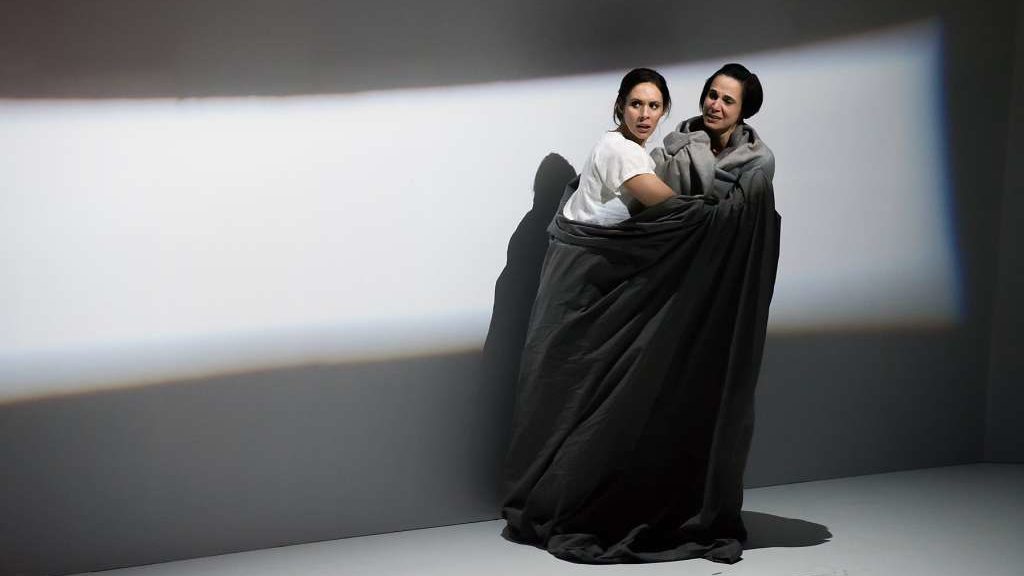
THE ‘QUARTER-STAGED’ ADAMS ORATORIO
Those patrons streaming out at intermission missed the best part of John Adams’ massive and ambitious oratorio “The Gospel According to the Other Mary.”
As in his earlier oratorio “El Niño,” this magnum opus links biblical narrative with modern-day people and issues via flashback and flashforward. Modern immigration, farm-workers’ rights and women’s activism enter into the scriptural accounts of Lazarus and Jesus, via the adroit texts compiled by librettist Peter Sellars, a frequent Adams collaborator.
If this succès d’estime was less than a success at the San Francisco Symphony and Chorus (Feb. 16), just pass the shears. The opening 85-minute act needs to be trimmed by half, focusing as it does, with a string of recitatives and soliloquies, on Lazarus’ being raised from the dead—-one of many miracles attributed to Jesus.
In contrast, the hour-long act two springs powerfully to life, a vital musical experience wrapped around Jesus’ passion and death, It is a self-contained entity, eminently suitable for separate performance with great effect.
Adams’ orchestra here finally becomes a dramatic force, with effusive brass and percussion leading the narrative in its jagged rhythms and harmonic instability. This is “gnarly” (his term, not mine) Adams at its most emotion-charged intensity.
His solo-vocal lines are demanding and far-reaching in range. He again marshals a trio of countertenors in close harmony for commentary (much as in “El Niño”) and for voicing the role of Jesus. The 50-member mixed chorus does the rest—sometimes Jesus, sometimes a Greek chorus repeating visionary poetry.
(If there was a miracle this night, it was the vowel-obsessed SFS Chorus finally spitting out distinct consonants and making the messages intelligible.)
Linking the acts was the story of Mary Magdalene, partly from the Bible, partly from beyond, a woman caught between her religious fervor and obsessive passion. This emphasis was a conscious focus on women—subordinate in the Scriptures, yet so significant in the aftermath. This is played out in the hymns of Saint Hildegard von Bingen as well as the activism of modern-day figures like Dolores Huerta and Dorothy Day.
For his texts, Sellars alludes to or quotes 20th-century writings of Cesar Chavez, Rosario Castellanos, Ruben Dario, June Jordan, Louise Erdrich and Primo Levi.
After the death and resurrection, Adams inserts a totally serene segment with the stylized sweet sound of frogs, delicately suggesting a renaissance awakening from the tragedy with promise of a brighter future. It is one of the most beautiful moments in all of Adams’ vast musical writings.
The huge opus was visually dramatized with stage, lighting, movement. Since the SFS veered away from terming it “semi-staged,” we’ll call it “quarter-staged” without further quibble over fractions.
The three solo singers filled the hall with their outpourings, but more vehemently than expressively: The mezzos Kelley O’Connor (title role) and Tamara Mumford (Martha, her sister), and tenor Jay Hunter Morris. The modern and the biblical clashed when ancient figures were spotted running about stage in sneakers. Director Elkhanah Pulitzer was plausible blocking the tableau-paced stage movement. Grant Gershon conducted with vehemence and rhythmic propulsion.
Berkeleyite John Adams, who has just turned 70 without conceding anything to old age, took bows afterward and was applauded more warmly than the work itself. “Back to the drawing board?”
Adams’ 2012 oratorio “The Gospel According to the Other Mary,” San Francisco Symphony and chorus, Grant Gershon conducting; a partially staged production. Two hrs., 45 min. Davies Symphony Hall, S.F. (Feb. 16) For SFS info: (415) 864-6000, or go online.